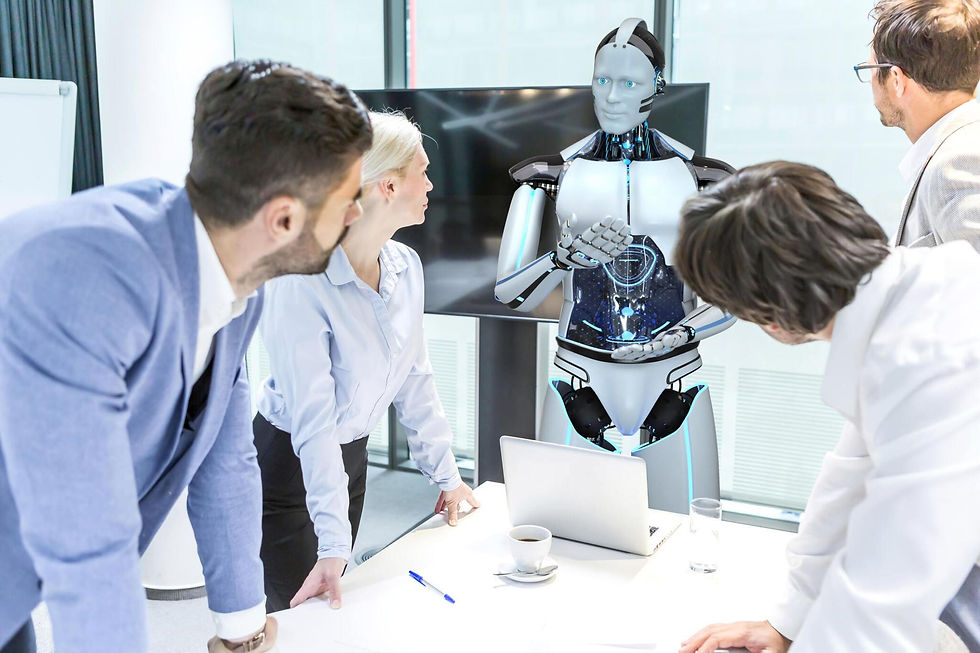Maximizing Business Efficiency: Incorporating AI and ML in Business Operations
- Cubefore LLC

- Feb 2, 2024
- 7 min read
Updated: Feb 3, 2024

Incorporating AI and ML in Business Operations
In today's rapidly evolving technological landscape, staying ahead of the curve is crucial for any business, especially in the realm of Artificial Intelligence (AI) and Machine Learning (ML). As an IT solutions company specializing in custom software development and app development, Cubefore LLC recognizes the transformative power of AI and ML in reshaping business operations. In this blog post, we'll delve into the strategic integration of these technologies and explore the myriad benefits they bring to the forefront of innovation.
Why AI and Machine Learning Integration Matters
The demand for AI solutions is skyrocketing, and projections from Next Move Strategy Consulting estimate the AI market to grow twentyfold by 2030, reaching a staggering value of nearly 100 billion U.S. dollars. As businesses ponder where to start, affordability, and seamless integration into existing workflows, we provide a roadmap to demystify the process and unlock the formidable benefits of AI and ML.

The inquiry arises: How can you integrate AI solutions into crucial organizational functions and why should you do so?
To discover the answers, delve into this blog post. We will elaborate on how the adoption of Artificial Intelligence can yield significant and varied business benefits.
The insights provided encompass pinpointing optimal starting points tailored to your business needs, evaluating long-term impacts, and expanding adoption.
Let's explore!
Understanding the Basics:
Before diving into the tangible benefits, it's crucial to grasp the fundamentals. AI and ML integration isn't just about adoption; it's a strategic move to enhance efficiency and productivity. As an app development firm, the integration of AI and ML into your existing processes is the key to staying competitive in the dynamic market.
As businesses rapidly advance, having a grasp of the fundamentals of AI and Machine Learning (ML) is crucial to stay competitive and future-proof. Let's simplify this for you:
1. Strategic Integration of AI and Machine Learning:
- Incorporating AI and ML into business operations requires seamless strategies that go beyond mere adoption. It involves strategically leveraging these technologies to enhance efficiency and productivity.
2. The Future of Business Operations with AI and ML:
- The future of business operations is closely tied to the integration of AI and ML. These technologies are not just passing trends; they are transformative forces reshaping how businesses function. Embracing them positions your business for long-term success.
3. Seamless AI and Machine Learning Integration:
- The key lies in integration. It's about seamlessly embedding AI and ML into your existing processes. It's not a standalone solution but a powerful enhancement to what you're already doing.
4. Dynamic Nature of Machine Learning Development:
- Machine Learning Development involves creating algorithms that enable machines to learn from data. It's a dynamic field that continually evolves to meet the demands of an ever-changing business landscape.
Incorporating Machine Learning models into software applications amplifies these benefits, fostering a dynamic and responsive operational environment. The choice of top Machine Learning frameworks, such as TensorFlow, PyTorch, or Scikit-Learn, plays a crucial role in aligning these technologies with your specific business needs.
Key Benefits of Integration:
Unlocking the potential of AI and ML integration yields transformative advantages:
Realizing the advantages of integrating AI and Machine Learning (ML) into business operations represents a strategic decision with transformative outcomes. Here's a simplified breakdown:
1. Strategic AI and Machine Learning Integration: The key lies in crafting a well-thought-out integration strategy. It's not merely about adopting AI and ML but seamlessly incorporating them into your operations to achieve maximum impact.
2. Embracing the Future of Business Operations with AI and ML: The future has arrived, intertwined with AI and ML. Embracing these technologies places your business at the forefront of innovation, ensuring adaptability and resilience in a dynamic market.
3. Optimal Machine Learning Frameworks: Selecting the right framework is akin to choosing the correct tools for the job. TensorFlow, PyTorch, and Scikit-Learn stand out as top contenders, each with unique strengths. Your decision should align with your specific business needs.
Now, let's delve into the concrete advantages:
1. Enhanced Decision-Making: Leverage the power of AI and ML to analyze vast datasets, extracting valuable insights for informed decision-making.
2. Improved Operational Efficiency: Streamline processes, boost efficiency through automation, and minimize errors with the seamless integration of AI and ML.
3. Personalized Customer Experiences: Tailor customer interactions based on predictive analytics, providing customized services that resonate and foster brand loyalty.
4. Increased Productivity and Automation: Automate routine tasks, allowing your team to focus on higher-value activities, enhancing overall productivity.
Integrating Machine Learning models into software applications enhances these advantages, contributing to a more dynamic and responsive operational environment. Moreover, harnessing AI and ML frameworks in predictive analytics and decision-making reinforces their significance as invaluable assets in molding a business landscape ready for the future. The crucial factor lies in careful integration and strategic implementation to unlock the complete potential of these technologies.
Challenges And Solutions:
Incorporating AI and Machine Learning (ML) into business operations presents its own set of challenges. Let's examine these potential pitfalls and delve into practical solutions:
Strategies for AI and Machine Learning Integration: Prior to addressing challenges, it is crucial to emphasize the significance of strategic integration. Comprehensive planning serves as the initial step in overcoming obstacles effectively.
Shaping the Future of Business Operations with AI and ML: Foreseeing potential challenges allows for a proactive approach to problem-solving, aligning your business with the ever-evolving landscape.
Understanding the Distinctions: When it comes to AI vs. Machine Learning vs. Deep Learning, grasping the fundamental differences is essential. AI serves as the overarching concept, ML as a subset, and Deep Learning as a specialized form. Clarifying these distinctions is vital for overcoming misconceptions and navigating the integration process successfully.
Now, let's explore the hurdles and their corresponding solutions:
1. Integration Complexity: Overcome the intricate nature of AI and ML integration by adopting a phased approach, starting with manageable projects before scaling up.
2. Data Quality and Security Concerns: Safeguard data integrity through robust measures, employing encryption protocols, and regular audits to maintain a secure environment.
3. AI Talent Shortage: Collaborate with top Machine Learning development companies or hire Machine Learning experts to augment your team's capabilities.
4. Resistance to Change: Facilitate comprehensive training programs, emphasizing the benefits and providing ongoing support to ease the transition.
Taking proactive steps to tackle these challenges allows businesses to navigate a smoother integration journey, unlocking the complete potential of AI and ML in predictive analytics and decision-making.
Steps to Integration:
Strategically approaching the integration of AI and Machine Learning (ML) into your business operations has the potential to be transformative. Now, let's delve into the key steps to guarantee a seamless integration:
1. Assess Business Needs: Identify areas where AI and ML can add value, pinpoint processes that could benefit from automation and predictive analytics.
2. Choose the Right Frameworks: Explore popular frameworks like TensorFlow or PyTorch, selecting based on business requirements, compatibility, and scalability.
3. Integrating Machine Learning Models Into Software Applications: Develop a plan for seamless incorporation, ensuring enhanced functionality without disruptions.
4. Training and Skill Development: Invest in training programs or hire machine learning experts to build internal capabilities for effective AI and ML utilization.
5. Pilot Projects for Testing: Initiate small-scale pilot projects, gather feedback, and address issues before scaling up.
6. Machine Learning for Business Optimization: Leverage machine learning for efficiency and productivity improvements, continuously monitoring and tweaking models to align with evolving business needs.
7. AI Solutions for Operational Challenges: Identify operational challenges and implement AI-driven solutions systematically.
Keep in mind that achieving successful integration is a continuous journey.
Consistently evaluate performance, collect feedback, and stay abreast of emerging technologies to ensure your business operations remain optimized and resilient. With the right approach, AI and ML can emerge as potent tools to tackle operational challenges and enhance overall efficiency.
Real-world Applications:
As Artificial Intelligence (AI) continues to integrate into various sectors, numerous businesses are undergoing swift transformations. Spearheading this revolution are forward-thinking companies that harness AI to redefine their operations and stimulate innovation across diverse industries.
Let's take a sneak peek into the transformative impact of AI on various industries:
1. Amazon employs AI to customize product recommendations, optimize supply chains, and combat fraudulent activities. Bank of America utilizes AI in the finance sector to enhance customer interactions, detect fraud, and manage investments. In healthcare, IBM Watson showcases its capabilities by diagnosing diseases, devising personalized care plans, and spearheading innovative treatments.
2. Siemens relies on AI to predict equipment failures, streamline production processes, and fortify quality control. Simultaneously, Uber utilizes AI in transportation for predicting traffic patterns, optimizing routes, and efficiently pairing riders with drivers.
3. IBM Watson stands as a revolutionary force in healthcare, employing machine learning in predictive analytics and decision-making. Watson analyzes medical images with unparalleled precision, collaborates with doctors, and tailors treatment plans based on individual genetic makeup, paving the way for more effective therapies and potential life-saving breakthroughs. IBM Watson seamlessly integrates technology with medical expertise, transforming patient care.
4. Uber's AI, driven by seamless integration of AI and machine learning, transcends its role as a mere ride-finding tool. It evolves into a traffic strategist, dynamically analyzing real-time traffic patterns. This intelligent system predicts congestion, offering a ride with a meticulously planned journey.
It's more than just locating the nearest driver; it's a seamless coordination of AI and machine learning, ensuring efficient routes that save invaluable commute minutes. Uber's dedication to AI and machine learning integration promises to seamlessly blend technology and human convenience, creating a smooth urban travel experience.
Summing Up:
In conclusion, the integration of AI and ML is not just a trend but a pivotal strategy for businesses striving to thrive. As an AI Services Company, Cubefore LLC offers strategic partnership for businesses looking to harness the power of AI and ML for optimization and innovation. The future belongs to those who embrace these technologies for sustainable growth and business efficiency.



Comments